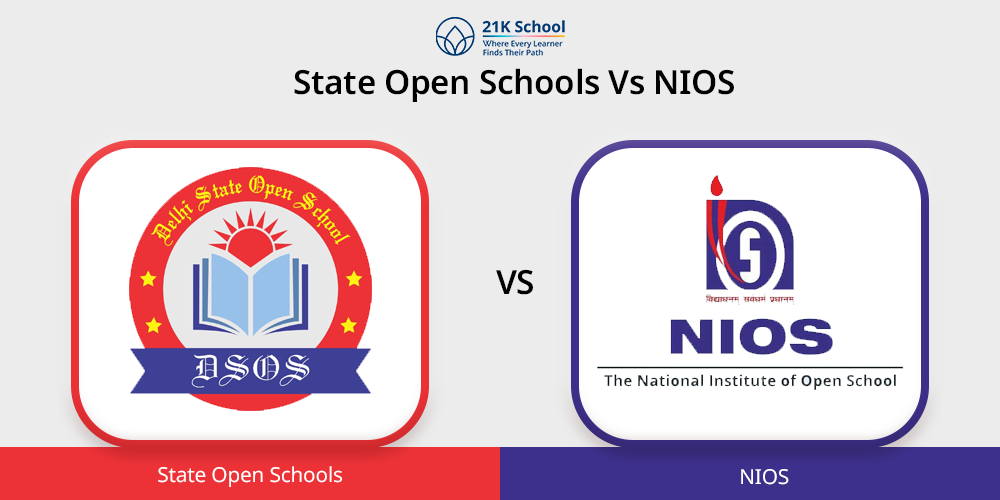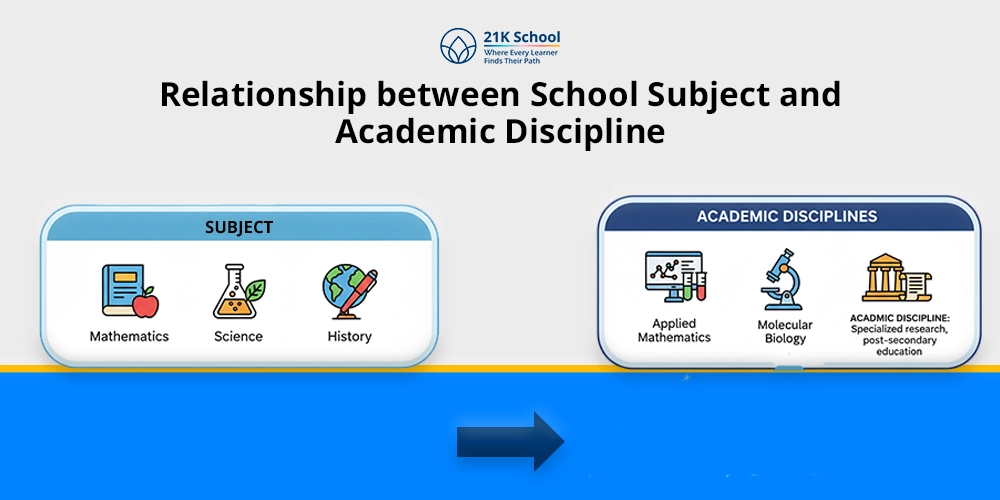
Do you know how State Open Boards and NIOS are different?
State Open Schools and NIOS are both open schooling system that provides distance education to students. State Open School and NIOS both offer flexible education to students, enabling them to learn at their own pace and learning style.
The National Institute of Open Schooling (NIOS) offers national-level education, whereas the State Open Board offers state-level education. Mostly, every state in India has its own open schooling boards .
One of the benefits of state boards is that they offer educational content in regional languages. State Open Schools and NIOS are a little different, which have different syllabus, curriculum , topics, and coursework.
The educational path and future prospects are greatly impacted by the choice of the board, the regulatory body that creates curricula, administers exams and issues certifications.
Contents
What is State Open School?
The state board of open schooling offers open and distance learning to students. This state’s open schools focus on making education accessible to marginalised and disadvantaged groups, such as adults, reserved candidates such as SC/ST/OBC and dropout students.
These boards offer a self-directed learning environment that allows students to learn at their own pace without being limited by the demands of regular school attendance. By administering exams that are comparable to those of traditional boards like the CBSE and ICSE they ensure that students receive recognized certifications upon passing them.
One of the distinguishing features of State Open Schooling is its emphasis on integrating students from a variety of backgrounds including those from economically disadvantaged groups in rural areas and those with disabilities.
For low-income students, continuing their education is easier because many of these boards offer free and cost-effective fee structures.
What is NIOS?
The National Institute of Open Schooling (NIOS) is an autonomous university established in the year 1989, under the Ministry of Education of the Indian government. It provides education to a diverse range of students including those who don’t have access to traditional schooling .
Through NIOS students can attend the classes in open and distance learning techniques. One of the main benefits of NIOS is it offers a flexible learning approach which enables students to choose classes and subjects at their own pace and study whenever it is most convenient for them.
NIOS syllabus is aligned with the National Curriculum Framework (NCF), which offers secondary and senior secondary education. NIOS offers an on-demand examination which allows students to appear for the examination when they are most prepared.
Difference Between State Open School Vs NIOS
State Open Schools vs NIOS are both open schools that offer flexible and distance education. State open schools mainly focus on regional centres whereas NIOS is central Open Schooling.
NIOS offers a more standardized and nationally recognized approach while State Open Schools provide varying degrees of flexibility and support to accommodate regional needs. Here are the detailed differentiation of NIOS and State Open Schools.
| Aspects | NIOS | State Open School |
| Recognition | NIOS is government-approved and aligns with the NCF curriculum, which aligns with public exam boards such as CBSE and ICSE. | State open schools are approved by state governments. The degree obtained might not be as widely recognised as compared to NIOS. |
| Curriculum | The curriculum of NIOS is aligned with NCF and offers a wide range of subjects, including vocational courses. | The curriculum of the state open school focuses on the state curriculum rather than NCF. The subjects are also focused on regional education. |
| Exam System | The exam system of NIOS conducts public examinations for secondary and senior secondary twice a year, along with that NIOS also offers on-demand examinations | The exam system of state open schools are varied, and every state has their own examination system and the flexibility varies from state to state. The on-demand examination also varies from different states |
| Admission Process | The admission of process of NIOS is simple and convenient, which allows admission for a longer period of time. | The admission process used by each state may vary. There may be set admissions periods in some states and rolling admissions in others |
| Certification | The pass certificate of NIOS is government-approved and is equivalent to any other boards, such as CBSE or ICSE | The passing certificates of state open schools are also approved by state governments, but might not always be as respected as NIOS certifications |
Here you can check the detailed differentiation of NIOS and the State Open University
1. Recognition
NIOS: NIOS is a government-recognised educational institution that offers open and distance education to students. It comes under the Ministry of Education Government of India. The board is recognised by most of educational institutions and higher education institutes as it aligns with the CBSE and ICSE.
State Open Schools: Each state may define these differently and they are under the preview of the respective state governments. Although their credentials are generally recognised in the state in which they are obtained, they might not be as widely recognised as compared to NIOS.
2. Curriculum
NIOS: The curriculum of NIOS is aligned with the National Curriculum Framework (NCF). This allows students to customise their education to fit their interests and career goals by offering a wide range of subjects, including vocational courses. The flexible design of the curriculum allows students to learn at their own speed and convenience.
State Open Schools: State open schools usually follow the state education board’s curriculum and not follow the NCF curriculum. The state board offers a wide range of subjects with a stronger focus on regional and local languages.
3. Examination System
NIOS: NIOS offers a flexible examination system that allows students to appear for the examination as per their own convenience. NIOS conducts public examinations for secondary and senior secondary twice a year, which gives ample time to students to appear for the examination.
Along with that, NIOS also offers on-demand examinations, which allow students to appear for the examination throughout the year.
State Open Schools: The examination system of state open schools also offers a flexible mode, where students can appear for the examination whenever they want. However, every state has their own examination system and the flexibility varies from state to state.
The on-demand examination also varies from different states as open schools in some states don’t provide on-demand examinations.
4. Certification Validity
NIOS: NIOS passing certificates are government-approved and are equivalent to any other boards, such as CBSE or ICSE. Through the NIOS certificate, students can enrol in any institution or can go for career opportunities.
State Open Schools: The passing certificates of state open schools are also approved by state governments, through which students can also apply to any higher educational institutions. However, state open school certifications might not always be as respected as NIOS certifications particularly when they are obtained outside of the state.
5. Admission Process
NIOS: NIOS enrollment is comparatively simple and can be completed online. Throughout the year students can sign up for a variety of courses at different levels such as secondary, senior secondary and vocational. Students are able to enrol whenever it is most convenient for them.
State Open Schools: The enrollment procedures used by each state may vary. There may be set admissions periods in some states and rolling admissions in others. Some students may find the process intimidating because it involves more steps like local documentation and verification.
Features of the State Open University
State Open Schooling is State state-recognised open school that offers open and distance learning to students. State open schools focus on regional education and place emphasis on regional language.
The main aim of state-open schools is to make education accessible to every individual irrespective of any challenges. The following are the features of state open schooling.
1. Focus on State Students
The main aim of State Open Universities is to meet the educational needs of students residing in the state. Focusing on the unique socio-economic problems and cultural dynamics of the area ensures that the curriculum is relevant to the local context.
State Open Schools provide people with the knowledge and skills necessary to contribute significantly to their communities. These institutions give priority to state students.
2. Government Approved
State Open Universities are accredited and government-approved. This endorsement attests to the institution’s compliance with accepted educational standards and laws, ensuring that the education provided is reliable and recognised.
Through the government’s legitimacy, degrees from government-approved educational boards are accepted by any other higher education institutions or career organisations.
3. Flexible Education
State open schools offer flexible education to students. This flexibility allows students to design their own learning paths by deciding how and when to study.
Students can tailor their education which fits their study schedule by enrolling in part-time programs or distance learning . The flexibility of the state board of open schooling enables them to pursue their academic goals without sacrificing their other commitments.
4. Remote Learning Opportunities
State open schools offer a remote learning environment for students enabling them to study from any location.
This eliminates geographical barriers to education enabling students to virtually access course materials, take part in discussions and finish assignments from anywhere. Remote learning opportunities are beneficial for students who can’t study in traditional schooling or are working individuals.
5. Reduce Dropout Rates
State Open Universities create a positive learning environment that encourages students for academic success by considering a variety of learning styles and life circumstances.
The flexible method of state open university allows students to appear for the examination if they have failed their public examination or want to improve their academic performance. This helps in reducing school dropout rates and enables students to start their studies without any hindrances.
Features of NIOS
NIOS offers flexible learning opportunities, which promote an inclusive learning environment. NIOS helps students to reappear for the examination if they have failed in their public board examination or want to improve their scores.
The government approval makes NIOS legitimate and recognised by every higher education institute. Here are the features of NIOS mentioned below.
1. Government Recognised
NIOS is a government-recognised institute which provides a recognised degree. Students need this recognition because it ensures that the degrees and certificates awarded by NIOS are authentic and accepted by many colleges and universities.
This legitimacy creates avenues for further education including college and university education in addition to employment prospects in the public and private sectors.
2. Open and Distance Learning
NIOS offers open and distance learning to enable students to study from any location irrespective of any challenges.
This model allows students to study from home or any other location of their choosing by utilising a variety of educational resources such as textbooks, online resources and multimedia content. Due to ODLs flexibility students can manage their studies in addition to other responsibilities like working or caring for their families.
3. Vocational Courses
NIOS provides vocational courses to students in the fields of Healthcare, IT, hospitality and agriculture. This provides students with real-world experience and hands-on training, NIOS gives students the tools they need to start working as soon as they graduate from college.
This emphasis on vocational training promotes an entrepreneurial mindset , which helps in enhancing employability.
4. On-demand Exam
NIOS offers on-demand examinations which allows students to appear for the examination as per theiconveniencety. As compared to traditional examination systems where students must follow a set schedule this flexibility represents a significant shift.
The on-demand exams alleviate the exam-stress and anxiety that are frequently connected to standardised examinations by allowing students to select their exam dates according to their readiness levels. Students are empowered to take charge of their educational journeys thanks to this system.
5. Multiple Exam Chances
Students are given multiple opportunities to retake the test if they are dissatisfied with their results. This policy will be especially helpful to students who might have test anxiety or who need more time to comprehend particular concepts.
NIOS allows students to retake tests and fosters a positive learning environment that rewards perseverance and growth.
Conclusion
In India State Open Schools and the National Institute of Open Schooling (NIOS) are both essential for giving diverse student populations flexible and affordable education.
State Open Schools address local needs by emphasizing regional languages and cultural contexts whereas NIOS provides a nationally recognized curriculum and examination system that is standardized.
Every system offers distinct benefits such as the on-demand exams and career training offered by NIOS and the focus on inclusivity for underrepresented groups by State Open Schools.
It is crucial for students to thoroughly weigh their options because, in the end, the decision between the two is based on their unique educational objectives, local factors, and needs.


